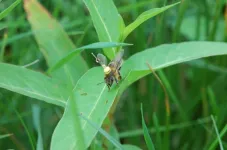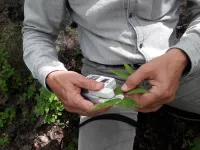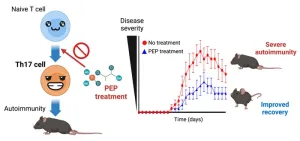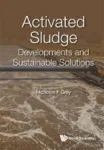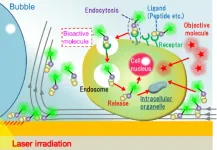(Press-News.org) In the earliest days of human flight, before the invention of the first radio beacons and ground-based electronic systems, and modern GPS, pilots commonly navigated by following roads and railways – striking linear landscape elements at ground level that guide towards a destination of interest.
Enter the honeybee. A century of research has shown that honeybees are navigators par excellence. They can navigate by their sense of smell, the sun, the sky’s pattern of polarized light, vertical landmarks that stand out from the panorama, and possibly the Earth’s magnetic field. They are also clever learners, able to recognize associations between disparate memories in order to generalize rules.
Now, scientists have shown that honeybees tend to search for their way home by orienting themselves in relation to the dominant linear landscape elements, just like the first pilots. The results are shown in Frontiers in Behavioral Neuroscience.
Dr Randolf Menzel, an emeritus professor at the Department of Neurobiology of the Free University of Berlin, and the study’s lead author, explained: “Here we show that honeybees use a ‘navigation memory’, a kind of mental map of the area that they know, to guide their search flights when they look for their hive starting in a new, unexplored area. Linear landscape elements, such as water channels, roads, and field edges, appear to be important components of this navigation memory.”
Tiny transponder
In late summer of 2010 and 2011 near the village of Klein Lüben in Brandenburg, Menzel and colleagues caught 50 experienced forager honeybees and glued a 10.5-mg transponder on their back. They then released them in a new test area, too distant to be familiar to the bees. In the the test area was a radar, which could detect the transponders at a distance of up to 900 meters. The most notable landmark in the test area was a pair of parallel irrigation channels, running southwest to northeast.
When honeybees find themselves in unfamiliar territory, they fly in exploratory loops in different directions and over different distances, centered on the release spot. With the radar, the researchers tracked the exact exploratory flight pattern of each bee for between 20 minutes and three hours. The bees flew at up to nine meters above the ground during the experiment.
The researchers had collected foragers from five hives: the home area around hives A and B resembled the test area in terms of the number, width, length, and angle of linear landscape elements, especially irrigation channels. The home range around hives D and E was highly dissimilar in this regard, while the home area around hive C was intermediate in similarity to the test area. Other landmarks by which honeybees are known to find their way, such as structured horizons or vertical elements that stand out, were absent in the test area.
Non-random search pattern
Menzel et al. first simulated two sets of random flight patterns, centered on the release spot, and generated with different algorithms. Since the observed flight patterns were highly different from these, the researchers concluded that the honeybees didn’t simply conduct random search flights.
The researchers then used advanced statistics to analyze the orientation of flights and their frequency of flying over of each 100 x 100 meter block within the test area. They showed that the honeybees spent a disproportionate amount of time flying alongside the irrigation channels. Analyses showed that these continued to guide the exploratory flights even when the bees were more than 30 meters away, the maximum distance from which honeybees are able to see such landscape elements. This implies that the bees kept them in their memory for prolonged periods.
“Our data show that similarities and differences in the layout of the linear landscape elements between their home area and the new area are used by the bees to explore where their hive might be,” said Menzel.
Navigational memory
Importantly, machine learning algorithms showed that the irrigation channels in the test area were most informative for predicting the exploratory flights of bees from hives A and B, less so for bees from hive C, and least for bees from hives D and E. This suggests that the bees retained a navigational memory of their home area, based on linear landscape elements, and tried to generalize what they saw in the test area to his memory to find their way home.
“Flying animals identify such extended ground structures in a map-like aerial view making them highly attractive as guiding structures. It is thus not surprising that both bats and birds use linear landmarks for navigation. Based on the data reported here we conclude that elongated ground structures are also salient components of the honeybees’ navigation memory,” concluded the authors.
END
Bees follow linear landmarks to find their way home, just like the first pilots
Study suggests that honeybees search for linear landscape elements that match mental map of home area
2023-03-06
ELSE PRESS RELEASES FROM THIS DATE:
Community strategy reduced opioid overdose deaths in Pennsylvania counties
2023-03-06
PITTSBURGH, March 6, 2023 — The monthly opioid overdose death (ODD) rate fell by 30% in Pennsylvania counties that implemented a novel community-focused strategy developed by University of Pittsburgh researchers, according to a new study published today in the Journal of Studies on Alcohol and Drugs.
By analyzing counties that did or didn’t implement the Pennsylvania Opioid Overdose Reduction Technical Assistance Center (ORTAC) strategy over time, the researchers estimate that this cost-effective, community-led approach prevented 1,818 opioid-related deaths over two years.
“I ...
A mixture of trees purifies urban air best
2023-03-06
Conifers are generally better than broadleaved trees at purifying air from pollutants. But deciduous tree may be better at capturing particle-bound pollution. A new study led by the University of Gothenburg shows that the best trees for air purification depend on the type of pollutant involved.
Trees and other greenery in cities provide many benefits that are important for the well-being of residents. Leaves and needles on trees filter air pollutants and reduce exposure to hazardous substances in the air. But which trees purify the air most effectively? Researchers from the University ...
Potential treatment of autoimmune diseases revealed in new study
2023-03-06
Scientists in Japan have revealed a chemical compound that could be used for the treatment of various autoimmune diseases like multiple sclerosis and rheumatoid arthritis. These diseases occur when the body’s immune response goes wiry. The immune system, which normally attacks pathogens and infections, instead attacks healthy cells and tissues. For the millions of people who suffer from autoimmune diseases worldwide, the result can be debilitating—rheumatoid arthritis causes excessive joint pain, while multiple sclerosis can disable one’s brain and spinal cord function.
“The key to the development of autoimmune ...
Physical activity and tailored support fails to deliver lasting benefits for smokers not ready to quit
2023-03-06
Promoting physical activity and other behavioural support can help people wanting to reduce their smoking to quit in the short-term.
However, after nine months, physical activity delivers no noticeable benefits – compared with offering no additional support – in the rates of people stopping smoking, according to the findings of a major national study.
The Trial of physical Activity and Reduction of Smoking (TARS) study, led by the University of Plymouth with funding from the National Institute for Health and Care Research, took place across four cities – Plymouth, Nottingham, Oxford and ...
Death rates from lung cancer will fall overall in the EU and UK in 2023, but rise among women in France, Italy and Spain
2023-03-06
A total of 1,261,990 people will die from cancer in 2023 in the EU (EU-27). A further 172,314 people will die from the disease in the UK, according to new research published in the leading cancer journal Annals of Oncology [1] today (Monday).
Researchers led by Carlo La Vecchia (MD), a professor at the University of Milan (Italy), estimate there will be a 6.5% fall in cancer death rates in men and a 3.7% fall in women between 2018 and 2023.
They predict that death rates from the ten most common cancers will continue to fall in most European countries in 2023, although the numbers of people dying will go up ...
As urban populations soar wastewater treatment struggles to find sustainable solutions
2023-03-06
Globally, activated sludge treats the majority of urban wastewaters; yet it is one of the most complex biological processes used. It is a sophisticated microbial process fraught with operational problems leading to occasional failures in achieving required effluent quality standards. With the increasing problem of partially treated and raw sewage entering rivers and estuaries, the pressure on the process to cope with ever increasing volumes of wastewater has never been so great.
With increasing volumes of dilute wastewater entering treatment plants the high variability in hydraulic and organic ...
Light-induced acceleration of intracellular delivery
2023-03-06
Cell membranes are barriers that maintain cellular homeostasis, and the intracellular delivery of biologically functional molecules, including peptides, proteins, and nucleic acids to manipulate cellular functions. Conventional intracellular uptake processes require high concentrations of biofunctional molecules with low permeability to pass through the cell membrane. This results in low drug activity because the probability of the biofunctional molecules entering target cells and their organelles is low. In addition, many drugs damage healthy cells as well as the cells that are supposed to target due to poor selectivity, making ...
Physician workforce planning must adjust for aging population, changing practice patterns: New analysis
2023-03-06
Why are Canadians having problems accessing physicians despite historic highs in physician numbers? Factoring in changing demographics and physician work trends can help with physician workforce planning, according to a new analysis in CMAJ (Canadian Medical Association Journal) https://www.cmaj.ca/lookup/doi/10.1503/cmaj.221239.
"[T]he increasing [health care] needs of an aging population have been empirically important since around 2005, while the supply of physician service hours has simultaneously declined in a manner that is largely unrelated to the evolving age–sex composition of the physician workforce," writes Dr. Arthur Sweetman, ...
Pregnant people with schizophrenia have threefold risk of interpersonal violence
2023-03-06
Pregnant and postpartum people with schizophrenia have a more than threefold increase in the risk of an emergency department visit for interpersonal violence, compared with those without schizophrenia, according to a new study in CMAJ (Canadian Medical Association Journal) https://www.cmaj.ca/lookup/doi/10.1503/cmaj.220689.
Interpersonal violence can include physical, sexual and psychological abuse by a family member, intimate partner, acquaintance or stranger.
"Though we found a threefold increased risk for individuals with schizophrenia, we also found that ...
Testing for ApoB protein may be a more accurate marker for heart disease risk than testing for cholesterol alone
2023-03-05
Getting tested for levels of HDL (the good) and LDL (the bad) cholesterol is part of the annual physical exam. But emerging research is showing that these standard tests may not be the most accurate way to test for heart disease risk.
Instead, emerging data suggest that testing for levels of Apolipoprotein B-100 (ApoB), a protein that carries fat molecules, including LDL cholesterol – the so-called “bad cholesterol” – around the body, may be a more accurate risk predictor of atherosclerotic cardiovascular disease, which occurs ...
LAST 30 PRESS RELEASES:
Numbers in our sights affect how we perceive space
SIMJ announces global collaborative book project in commemoration of its 75th anniversary
Air pollution exposure and birth weight
Obstructive sleep apnea risk and mental health conditions among older adults
How talking slows eye movements behind the wheel
The Ceramic Society of Japan’s Oxoate Ceramics Research Association launches new international book project
Heart-brain connection: international study reveals the role of the vagus nerve in keeping the heart young
Researchers identify Rb1 as a predictive biomarker for a new therapeutic strategy in some breast cancers
Survey reveals ethical gaps slowing AI adoption in pediatric surgery
Stimulant ADHD medications work differently than thought
AI overestimates how smart people are, according to HSE economists
HSE researchers create genome-wide map of quadruplexes
Scientists boost cell "powerhouses" to burn more calories
Automatic label checking: The missing step in making reliable medical AI
Low daily alcohol intake linked to 50% heightened mouth cancer risk in India
American Meteorological Society announces Rick Spinrad as 2026 President-Elect
Biomass-based carbon capture spotlighted in newly released global climate webinar recording
Illuminating invisible nano pollutants: advanced bioimaging tracks the full journey of emerging nanoscale contaminants in living systems
How does age affect recovery from spinal cord injury?
Novel AI tool offers prognosis for patients with head and neck cancer
Fathers’ microplastic exposure tied to their children’s metabolic problems
Research validates laboratory model for studying high-grade serous ovarian cancer
SIR 2026 delivers transformative breakthroughs in minimally invasive medicine to improve patient care
Stem Cell Reports most downloaded papers of 2025 highlight the breadth and impact of stem cell research
Oxford-led study estimates NHS spends around 3% of its primary and secondary care budget on the health impacts of heat and cold in England
A researcher’s long quest leads to a smart composite breakthrough
Urban wild bees act as “microbial sensors” of city health.
New study finds where you live affects recovery after a hip fracture
Forecasting the impact of fully automated vehicle adoption on US road traffic injuries
Alcohol-related hospitalizations from 2016 to 2022
[Press-News.org] Bees follow linear landmarks to find their way home, just like the first pilotsStudy suggests that honeybees search for linear landscape elements that match mental map of home area
